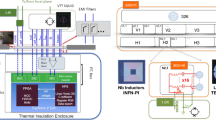Abstract
With applications in cosmology, infrared astronomy and CMB survey, frequency-division multiplexing (FDM) proved to be a viable readout for transition-edge sensors (TESs). We investigate the occurrence of out-of-band resonances (OBR) which could constrain the bandwidth of the FDM readout of TES bolometers. The study includes SPICE modeling of the entire setup including the cryogenic harness, LC filters, Superconducting Quantum Interference Device (SQUID) and room-temperature amplifier. Simulation results show that the long harness (for flight model) could cause multiple reflections that generate repetitive spikes in the spectrum. Peaks of the OBR are mainly due to the parasitic capacitances at the input of SQUID. Implementing a low-pass RC circuit (snubber) at the input of the SQUID dampened the OBR. As a result, the first peak only appears around 20 MHz which is a safe margin for the 1 MHz\(-\)3.8 MHz FDM in use in the prototype readout. Using a spectrum analyzer and broadband LNAs, we also measured the OBR for the prototype FDM readout in the laboratory up to 500 MHz. The measurement was conducted at temperatures of 50 mK and 4 K and for various biasing of the DC SQUID. It turns out that OBRs are more intense at 50 mK and are caused by the harness impedance mismatch rather than the SQUID. Simulation codes and supporting materials are available at https://github.com/githubamin/LT-Spice-Simulation-of-FDM-readout.







Similar content being viewed by others
References
K.D. Irwin, Phys. C Supercond. 368, 203–210 (2002)
Ridder, et al., Proceedings, 16th International Workshop on Low Temperature Detectors (LTD 16), 60–65, (2015)
R. A. Hijmering, et al., SPIE Proceedings, 107081A, https://doi.org/10.1117/12.2313715,(2018)
Suzuki et al., J. Low Temp. Phys. 184, 805 (2016)
Benson et al., Proceedings of the SPIE, Vol. 9153, id. 91531P 21 (2014)
Allys et al., LiteBIRD Collaboration, Progress of Theoretical and Experimental Physics, ptac150, (2022)
E-SQUID Project Report, https://cordis.europa.eu/project/id/262947/reporting (2014)
H. Akamatsu et al., Appl. Phys. Lett. 119(18), 182601 (2021)
R. Den Hartog et al., AIP Conf. Proc. 1185, 261 (2009)
Q. Wang et al., Rev. Sci. Instrum. 92, 014710 (2021)
M.D. Audley et al., J. Low Temp. Phys. 199, 723–729 (2020)
J. Knuutila et al., J. Low Temp. Phys. 68, 269–284 (1987)
T. Elleflot et al., J. Low Temp. Phys. 209, 693–701 (2022)
R. Den Hartog et al., J. Low Temp. Phys. 167, 652–657 (2012)
LT-SPICE simulator, www.analog.com/en/design-center/design-tools-and-calculators/ltspice-simulator.html
K.D. Irwin, G.C. Hilton, Topics Appl. Phys. 99, 63–149 (2005)
M. D. Audley, et al., 18th Int. Workshop on Low Temperature Detectors(LTD-18) (2019)
Q. Wang et al., Appl. Phys. Lett. 119(18), 182602 (2021). https://doi.org/10.1063/5.0065570
M. Kiviranta, E-Print arXiv:2103.11465v1, (2021)
M. Kiviranta, IEEE Trans. Appl. Supercond. 31(5), 1–5 (2021)
H. Weinstock, SQUID Sensors: Fundamentals, Fabrication, and Applications (Springer, New York, 1996)
D. Drung, In: IEEE/CSC & ESAS Superconductivity News Forum (2016)
X. Yan, et al., IEEE Trans. Appl. Supercond. 25(3) (2015)
Acknowledgements
We thank Kevin Ravensberg, Marcel van Litsenburg and Alex Simon at SRON workshop. We also thank anonymous referees for their constructive comments. SRON is supported financially by NWO, the Netherlands Organization for Scientific Research. Amin Aminaei is the recipient of the Brinson Prize Fellowship at UC Davis.
Author information
Authors and Affiliations
Corresponding author
Additional information
Publisher's Note
Springer Nature remains neutral with regard to jurisdictional claims in published maps and institutional affiliations.
Rights and permissions
Springer Nature or its licensor (e.g. a society or other partner) holds exclusive rights to this article under a publishing agreement with the author(s) or other rightsholder(s); author self-archiving of the accepted manuscript version of this article is solely governed by the terms of such publishing agreement and applicable law.
About this article
Cite this article
Aminaei, A., Akamatsu, H., Nieuwenhuizen, A.C.T. et al. Simulation and Measurement of Out-of-Band Resonances for the FDM Readout of a TES Bolometer. J Low Temp Phys 211, 338–345 (2023). https://doi.org/10.1007/s10909-023-02958-2
Received:
Accepted:
Published:
Issue Date:
DOI: https://doi.org/10.1007/s10909-023-02958-2




